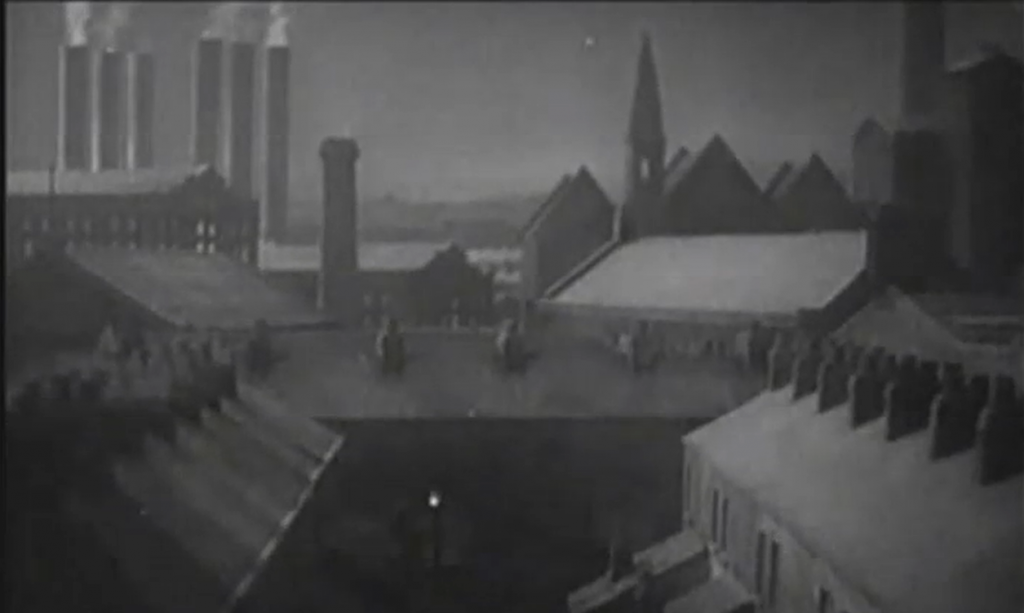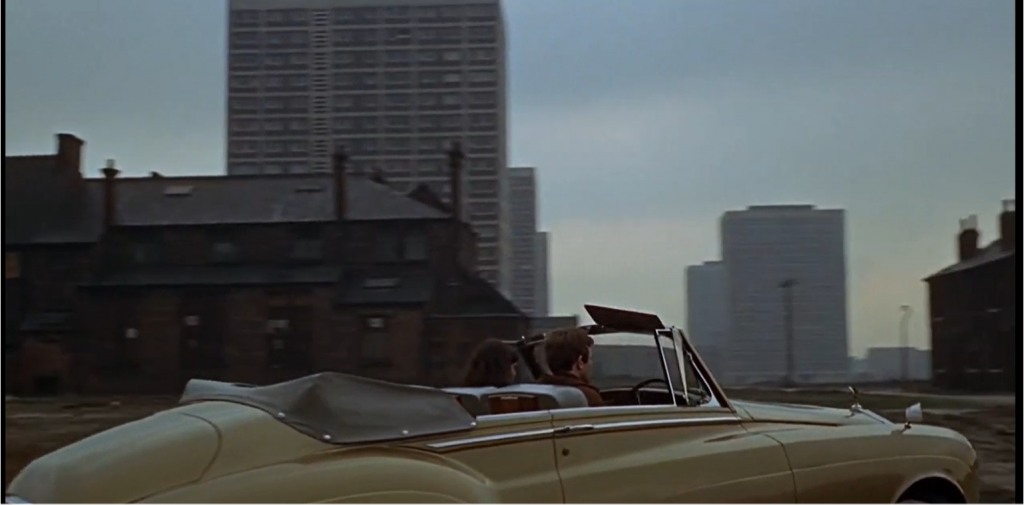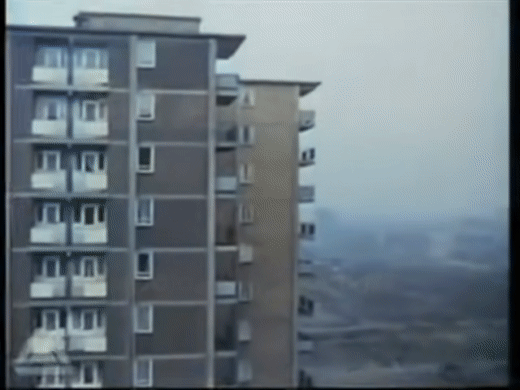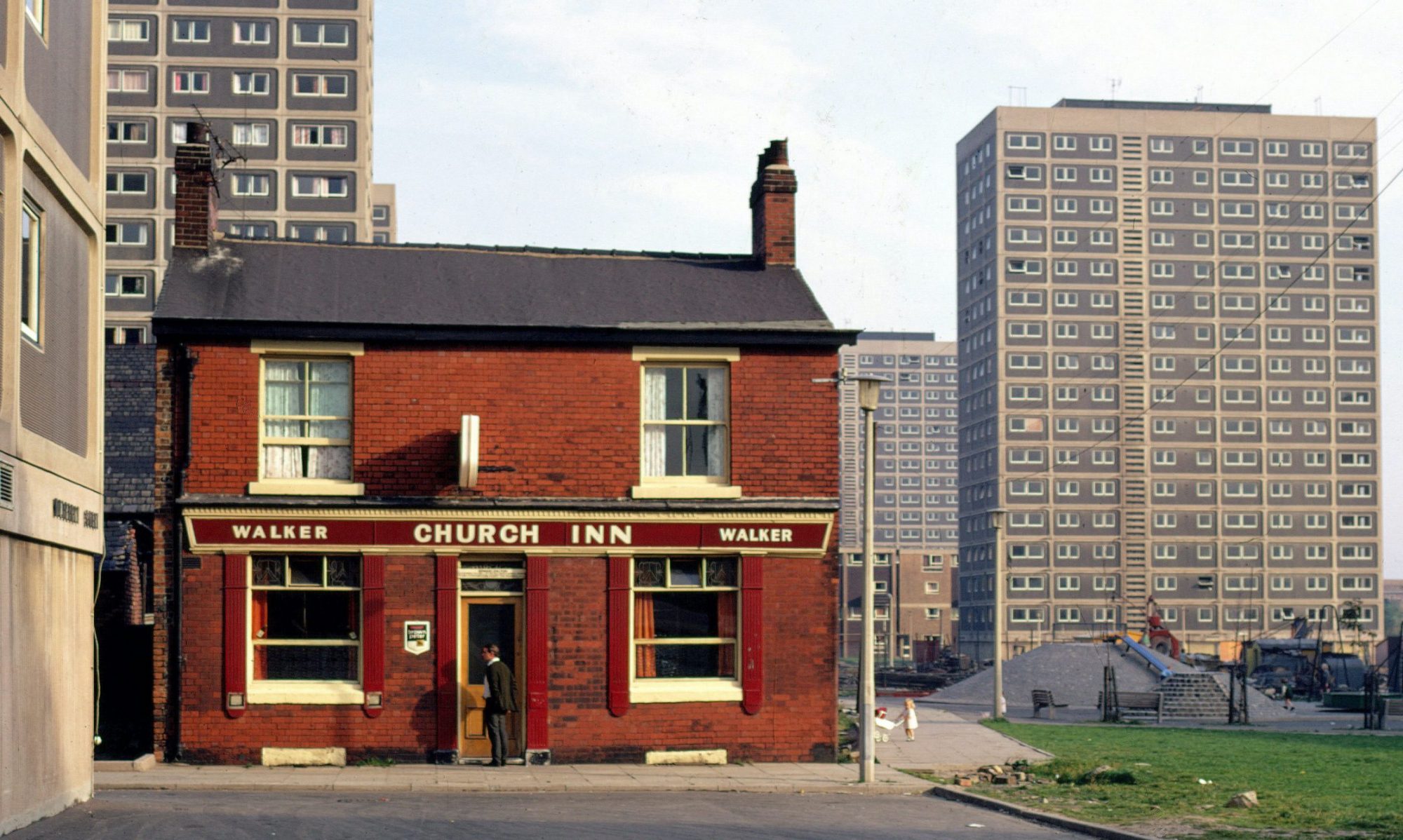This is guest post from Dr Jonny Smith, researcher and teaching assistant at the University of Manchester. Jonny’s research is primarily interested in British cinema with a particular focus on architecture, regionality and placemaking. In April 2022 he completed his PhD at the University of Manchester examining the representation and utilisation of Brutalist architecture in post-war British cinema. In this blog post Jonny discusses how Salford has been represented in film and television, particularly cinematic visions of the city’s extensive post-war redevelopment and “slum clearances”.
As previous blog posts on Love on the Dole (1933), The Classic Slum (1971) and Michael Goodger’s trilogy of early 1970s documentaries have all alluded to, Salford’s identity is bound up in its cultural representations. Furthermore, when one thinks of Salford, the image constructed is inevitably bound up in visions of working-class life and the industrial architecture of Victorian Britain. Harkening back to Friedrich Engel’s characterisation of Salford in the nineteenth century as “an old and therefore very unwholesome, dirty, and ruinous locality” (notably “much worse than that of Manchester”), the city has come to both tangibly and culturally represent the fate of Britain’s working classes. Nowhere has this notion been better understood and viscerally realised than through Salford’s numerous representations in film and television.
Salford’s on-screen existence through the likes of Love on the Dole (1941), A Taste of Honey (1961), Charlie Bubbles (1967) and Coronation Street (1960-) is bound up in the story of the city’s working-class communities, particularly the upheaval and change they faced during the twentieth century. Nowhere in Britain has quite as viscerally encapsulated and depicted working-class life like Salford – a reality that has left it synonymous with the past, but also a constant reminder of what has been lost over the past century. In many ways Salford has never escaped this narrative and its cultural identity remains bound up in the iconography of 1960s film and television.

Salford’s first notable cinematic appearances came courtesy of literary adaptations of Hobson’s Choice (1954) and Love on the Dole (1941), two works by local writers Harold Brighouse and Walter Greenwood respectively. Both films would build on Engel’s conception of Salford as a city defined by working-class life, Victorian architecture and capitalist exploitation. These themes are especially pertinent to Love on the Dole which, explores the impacts of the Great Depression on the working-class people of Hanky Park in Salford. The film’s opening prologue contextualises Hanky Park as a ‘region of poverty and darkness’ before matching such bleak terms with an establishing shot that pans over a model-built landscape of terrace streets, pillowing chimneys and redbrick warehouses. As the camera enters one of the terrace houses, a woman lights her stove with a copy of The Manchester Evening News – “Trade Boom is Coming” reads the headline, an ambition that quite literally goes up in flames with the arrival of the Great Depression.
However, the events of Love on the Dole are not merely confined to history, but instead directly spoke to the concerns of Britain’s wartime population. The film ends with an epilogue quote from the wartime Labour MP A.V. Alexander:
“Our working men and women have responded magnificently to any and every call made upon them. Their reward must be a New Britain. Never again must the unemployed become forgotten men of the peace”.
The story of Salford is then emblematic of the concerns of an entire nation, this final quote gesturing to the optimism of the soon-to-be post-war Welfare State and with it the promise to serve the working-class population. As terraced streets made way for high-rise tower blocks in the 1960s, the egalitarian and utopian ambitions of the post-war settlement would soon crystallise into feelings of loss and anger.
Robert Roberts’ book The Classic Slum: Salford Life in the First Quarter of the Century, published in 1971 chronicled his own experiences living of living through the poverty of Edwardian Salford. In the book’s preface, Roberts’ strikes a tone of loss at the city’s extensive post-war “slum clearances”:
“‘They’re knocking our life and times away!’ said an elderly Mancunian. We stood together gazing over the wilderness on which still another vast slum had been razed, and he spoke in grief. A kind of culture unlikely to rise again had gone in the rubble and he knew it.”
These sentiments, that the “New Britain” promised at the end of Love on the Dole had both failed to materialise and actively decimated communities, were echoed in two films at the end of decade, The White Bus (1967) and Charlie Bubbles (1967). Both films were written by local playwright and author Shelagh Delaney and visually illustrated her prior criticisms of the slum clearances in Salford, as well as greater personal anxieties about how fame had changed her relationship with her hometown.[1]

Charlie Bubbles, which was both directed by and starred Salfordian Albert Finney, follows the loose narrative of a successful London-based writer returning to his hometown of Salford for the weekend. In one standout sequence Bubbles drives through the deserted and decimated streets of Salford in his gold convertible Rolls Royce. In returning to the streets of his childhood, or at least what’s left of them, Charlie Bubbles draws a sharp critique of the policy of “slum clearances” (which was heavily concentrated in Manchester and Salford).[2] The sequence draws a notable contrast between the condemned terrace streets, boarded up and void of life, and the new Modernist tower blocks rising up across the misty landscape.
The White Bus also offers a satirical, sideways glance at Salford’s 1960s redevelopment (and rebranding). Directed by Lindsay Anderson with a surreal touch, the film centrally parodies the real-life introduction of a tourist bus through Salford in 1961 to boost the city’s image (one that had apparently been tarnished by Delaney’s previous literary depictions of Salford). In an overall attack on the pomposity of Salford’s mayoral and municipal authorities, The White Bus features a sequence that runs through the new Kersal Estate and views it with a satirical and scathing lens. Driving through estate, the tour guide speaks of the development’s success and the council’s pride at its construction, “flat dwelling has not been popular up to now but we’re breaking down this resistance by showing how to live in flats if they’re well planned and situated by pleasant surroundings”. In keeping with the film’s rich irony, both the tour guide’s gushing commentary and the wide tracking shots of the estate are immediately undermined by the subsequent cut to a backdrop of billowing industrial smog, as well as a passenger’s remark to “watch out for the gasworks”.
In contrast to the urban upheaval depicted in The White Bus and Charlie Bubbles, Salford’s cultural identity has been defined by the familiar terrace streets of A Taste of Honey and Coronation Street. While A Taste of Honey was a theatrical sensation in London’s West End, penned by Delaney at only 19-years-old, its 1961 cinematic adaptation, directed by Tony Richardson would centralise the iconography of Salford in the gritty tale of teenager Jo struggling to deal with her pregnancy after a one-night stand with a Black sailor. The film itself is an amalgamation of Manchester and Salford locations creating an impressionistic collage of a distinctly industrial and Victorian city.

Film academics such as John Hill and Andrew Higson have criticised the film’s indulgent and extraneous use of these Northern townscapes, particularly their appeal to an outsider or middle-class voyeurism. However, local critical and media responses to the film found its gritty evocation of Salford as one of the film’s great strengths, especially compared to the original play – The Guardian, then still based in Manchester, noted the film’s “remarkable air of naturalness” achieved by the story being “taken out of a small stage-set and put into a large, drab yet picturesque hurly-burly of a northern industrial town”. Similarly, The Sunday Telegraph stated how “this brilliantly directed film…really does take us to Salford, steeps us in such a town’s way of life”.
A Taste of Honey’s attempt to poetically and authentically capture a sense of working-class community in Salford would be matched by the creation of Coronation Street in 1960 by Granada Television. In a time of great upheaval and change in not just Salford, but working-class areas across the country, Coronation Street offered an escapist window into an unchanging world – in particular one out of the reach urban “slum clearances”. Coronation Street’s rejection of post-war modernity and identification as a safe unchanging slice of working-class Salford is epitomised by the 1969 title sequence. The opening includes a high angled panoramic shot of Salford that pans away from a tower block to zoom in on the spread of terrace houses far away, as if to literally take the viewer out of the present and into the past. In one sense this sequence plays on the nostalgic properties of Coronation Street’s representation of working-class life, but equally it gestures to realities of post-war redevelopment as slum clearances and new Modernist tower blocks reconfigured the landscape. Ironically Archie Street, which provided the physical inspiration for Coronation Street’s design – and can be seen in the original opening credits – was demolished in 1971 making its fictional counterparts existence all the more pertinent.
Coronation Street’s cobbled streets, terrace houses and close-knit working-class community remain large intact sixty years on from its initial episodes. The soap’s continued popularity and appeal is intrinsically bound up in its nostalgic, ossified vision of working-class life in Salford – one untouched by wrecking ball of the 1960s or the subsequent class division and polarisation of neoliberalism. Coronation Street is just one example of Salford’s cultural identity being viewed primarily through the past; whether it be retrospectives of Shirley Baker’s post-war street photography, the enduring presence of the Victorian Lark Hill Place at Salford’s Museum, articles about how much contemporary Salford still resembles Love on the Dole [3] or the ever-popular music and imagery of The Smiths. We then remain fascinated by Salford’s working-class history and landscapes, both as a window into the past but also in how they might speak to wider post-war histories of Britain too.
While representations of Salford in film and television have dwindled since the 1960s, notable exceptions include Mike Leigh’s BBC ‘Play for Today’ Hard Labour (1973) and East is East (1999), there have been a couple of recent developments. Coronation Street recently announced the introduction of a new set away from the famous cobbles, a two-storey shopping centre based on real-life 1960s designs in Salford, the Weatherfield Precinct. While the Precinct remains an archaic proposition via its outmoded modernist design, it does gesture towards Coronation Street embracing a broader, more contemporary embodiment of working-class Salford. [4]
Similarly, Salford-set dark-comedy Strangeways Here We Come (2018) has recently found an audience on Netflix. Despite being panned by UK reviews upon its release and attacked for perpetuating regressive stereotypes, the film’s director Chris Green, who grew up in Lower Broughton, has defended the film’s depiction of Salford as reflecting his own experiences, “at the end of the day, all those unsavoury characters who are a bit brutal, are part of a community. When the chips are down, like the Salford communities I remember, they all come together to help each other out” (2022).[5] While the politics of class representation remain contentious (a theme running throughout cultural depictions of Salford) its significant to see Strangeways Here We Come situating its narrative a contemporary Salford with the film’s central plot revolving around the residents of a 1960s high rise. Coupled with the introduction of Weatherfield Precinct, Strangeways Here We Come’s utilisation of 1960s point blocks (around the site of Hanky Park) suggests that perhaps Salford’s cultural existence is beginning to catch-up with its material reality – one no longer tied to the trauma of “slum clearances” or nostalgia for terrace streets.
The contemporary debates around Strangeways Here We Come once again stresses the importance of cultural representations on understandings of place and identity. For Salford this is particularly pertinent with its rich history of film, television and cultural representations exerting as much influence over the city’s identity in the twentieth century as post-war urban planners. It would be easy to say we need to look beyond Salford’s industrial heritage and nostalgic dreams of terrace streets, but through the likes of Coronation Street, Charlie Bubbles and A Taste of Honey, the trauma of “slum clearances” and politics of disenfranchisement reminds us that there is great value in turning to our past to forge a much optimistic future.
[1] Delaney’s most overt attacks on Salford’s redevelopment can be found in the BBC Special Shelagh Delaney’s Salford (1960), directed by Ken Russell.
[2] As per Jim Yellings data on the extent of Slum Clearances between 1955-1985, he finds Manchester and Salford demolished a higher proportion of its housing stock than anywhere else in the country with 35 and 33% respectively (2000).
[3] https://www.theguardian.com/books/2010/aug/07/rereading-love-dole-walter-greenwood
[4] The show’s producer Iain MacLeod has said of the new set: “They took their inspiration from Salford’s many real-world, late 20th century shopping areas and what they have created is a brilliant, characterful space to tell a diverse range of stories….Expect to see teens hanging out at the dessert shop, families enjoying the play area and, after dark, a rogues’ gallery, up to shady business in the ginnels” (ITV, 2021)
[5] Green defending his film for the Manchester Evening New (https://www.manchestereveningnews.co.uk/whats-on/film-news/salford-lad-who-directed-film-25464514?_ga=2.160376125.1240036018.1671049476-8119302825.1671049475)


One Reply to ““We Cannot Cling to the Old Dreams Anymore”: Exploring Post-War Change in Salford in Film & Television”